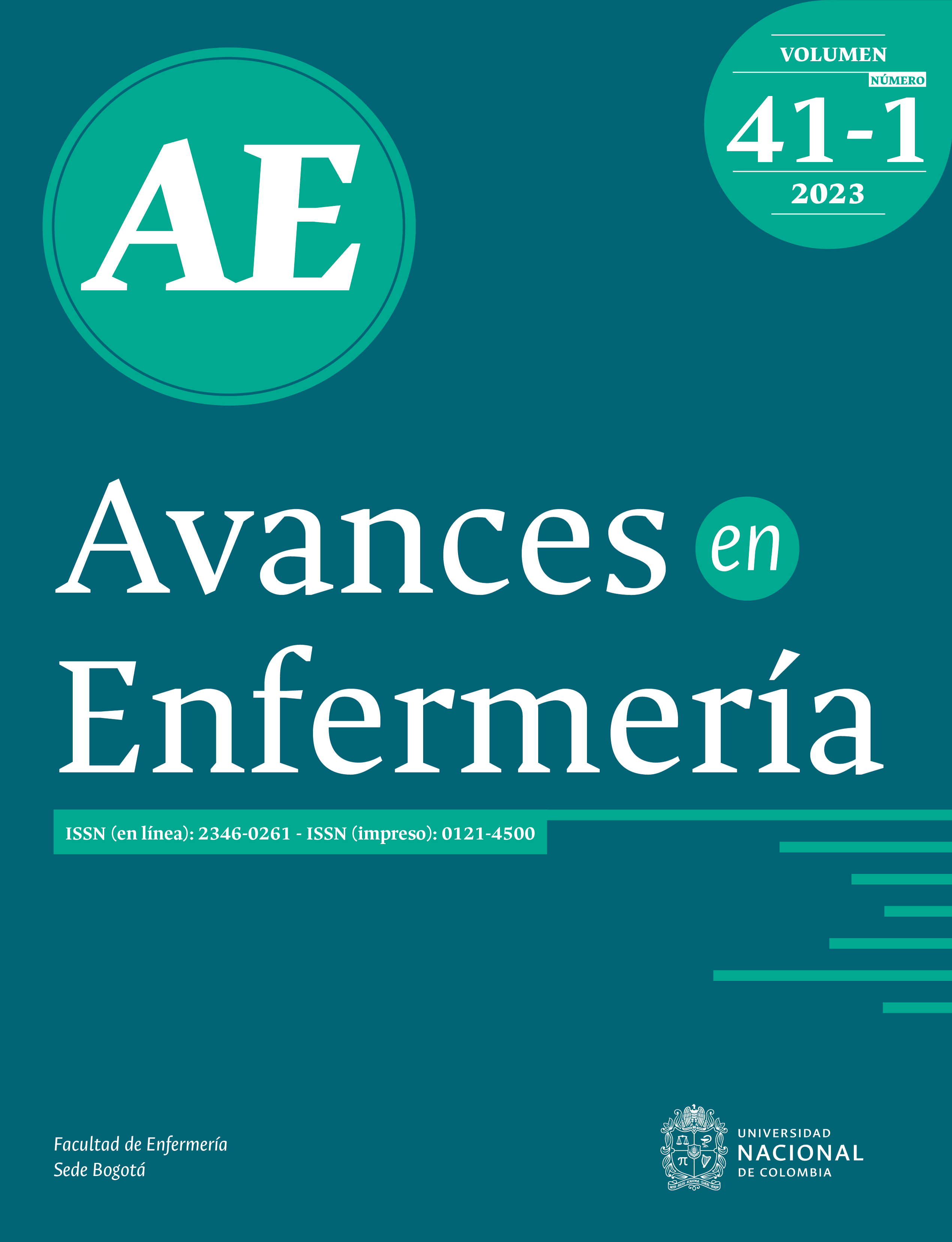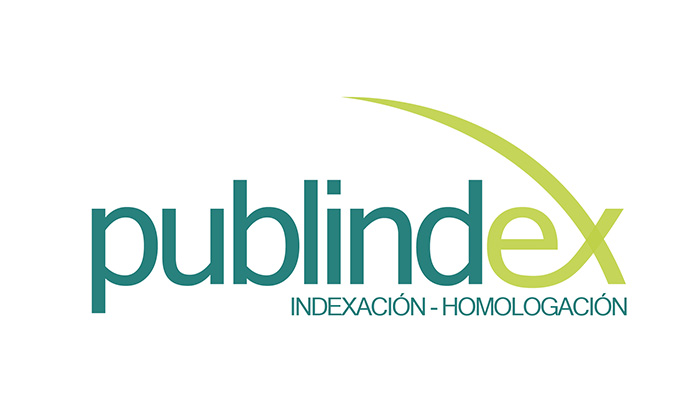Impactos de la implementación del programa Proadi-SUS en la reducción de infecciones en UCI
Impact of the implementation of the Proadi-SUS program on the reduction of 3 infections in ICUs
Impactos da implantação do programa Proadi-SUS na redução de infecções em UTI
DOI:
https://doi.org/10.15446/av.enferm.v41n1.101113Keywords:
Infección Hospitalaria, Enfermería, Seguridad del Paciente, Unidad de Cuidados Intensivos (es)Unidade de Terapia Intensiva, Infecção Hospitalar, Enfermagem, Segurança do Paciente (pt)
Intensive Care Unit, Cross Infection, Nursing, Patient Safety (en)
Downloads
Introducción: las infecciones relacionadas con la asistencia sanitaria (IRAS) son complicaciones frecuentes en los entornos de cuidados intensivos con alta morbilidad y mortalidad y altos costos para el sistema de salud, por lo que comprometen la seguridad del paciente y requieren medidas de prevención adecuadas.
Objetivo: analizar los resultados obtenidos en cuanto a la reducción de la incidencia de IRAS tras la ejecución del Programa de Apoyo al Desarrollo Institucional del Sistema Único de Salud (Proadi-SUS) en un hospital universitario.
Materiales y método: estudio retrospectivo, observacional y cuantitativo realizado en una unidad de cuidado intensivo general de 10 camas en un hospital universitario. El periodo evaluado fue de 2015 a 2019. Para el análisis estadístico se utilizó ANOVA y prueba de Kruskal Wallis.
Resultados: se reportó una reducción significativa en la incidencia media de IRAS (p = 0,000), muertes por IRAS (p = 0,042), neumonía asociada al ventilador (p = 0,000) e infección del tracto urinario asociado a sonda vesical (p = 0,004). Sin embargo, no hubo diferencias estadísticamente significativas en la incidencia media de infección del torrente sanguíneo asociada a catéter vascular central (p = 0,871).
Conclusiones: los cambios en la atención implementados durante el proyecto Proadi-SUS fueron efectivos para mejorar las tasas de IRAS y asegurar una mejor práctica de atención con mayor seguridad para el paciente.
Introduction: Health Care Related Infections (HAIs) are frequent complications in intensive care settings with high morbidity and mortality rates and high costs for the health system. Therefore, HAIs compromise patient safety and require adequate prevention measures.
Objective: To analyze the results obtained in the course of the Support Program for the Institutional Development of the Unified Health System (Proadi-SUS) in a university hospital in terms of the reduction of HAIs incidence.
Materials and method: Retrospective, observational, and quantitative study conducted in a 10-bed general intensive are unit (ICU) at a university hospital. The period evaluated was from 2015 to 2019. ANOVA and the Kruskal Wallis test were used for statistical analysis.
Results: There was a significant reduction in the mean incidence of HAIs (p = 0.000), HAI deaths (p = 0.042), ventilator-associated pneumonia (p = 0.000), and urinary tract infection associated with bladder catheters (p = 0.004). However, there were no statistically significant differences in the mean incidence of central vascular catheter-associated bloodstream infection (p = 0.871).
Conclusion: The care changes implemented during the Proadi-SUS project were effective in improving HAI rates and ensure better care practices and more patient safety.
Introdução: as infecções relacionadas à assistência à saúde (Iras) são complicações frequentes em ambientes de terapia intensiva, com alta morbidade e mortalidade, altos custos para o sistema de saúde que comprometem a segurança do paciente e requerem medidas de prevenção adequadas.
Objetivo: analisar os resultados obtidos na redução da incidência de Iras, durante o Programa de Apoio ao Desenvolvimento Institucional do Sistema Único de Saúde (Proadi-SUS) em um hospital universitário.
Materiais e método: estudo retrospectivo, observacional, quantitativo, realizado em uma unidade de terapia intensiva geral de 10 leitos de um hospital universitário. O período avaliado foi de 2015 a 2019. Para a análise estatística, foram utilizados ANOVA e teste de Kruskal Wallis.
Resultados: houve uma redução significativa na incidência média de Iras (p = 0,000), mortes por Iras (p = 0,042), pneumonia associada à ventilação mecânica (p = 0,000) e infecção do trato urinário associada a cateteres vesicais (p = 0,004). No entanto, não houve diferenças estatisticamente significativas na incidência média de infecção da corrente sanguínea associada ao cateter vascular central (p = 0,871).
Conclusões: as mudanças assistenciais implantadas durante o projeto Proadi-SUS foram efetivas em melhorar os índices de Iras e garantir uma melhor prática assistencial com mais segurança ao paciente.
References
(1) Haque M; Sartelli M; McKimm J; Abu Bakar M. Health care-associated infections - An overview. Infect Drug Resist. 2018;11:2321-2333. https://doi.org/10.2147/IDR.S177247 DOI: https://doi.org/10.2147/IDR.S177247
(2) Alp E; Damani N. Healthcare-associated infections in intensive care units: Epidemiology and infection control in low-to-middle income countries. J Infect Dev Ctries. 2015;9(10):1040-1045. http://doi.org/10.3855/jidc.6832 DOI: https://doi.org/10.3855/jidc.6832
(3) Carmo BKO; Santos BP; Nascimento CL; Veloso NF; Pamplona ND; Martins R et al. Ocorrência de iatrogenias a pacientes assistidos em Unidade de Terapia Intensiva: Uma revisão integrativa da literatura. REAS. 2019;(36):e1711. https://doi.org/10.25248/reas.e1711.2019 DOI: https://doi.org/10.25248/reas.e1711.2019
(4) Farias CH; Gama FO. Healthcare-associated infections in patients admitted to a cardiological intensive care unit. Rev Epidemiol Control Infect. 2020;10(3). https://doi.org/10.17058/reci.v10i3.15406 DOI: https://doi.org/10.17058/reci.v10i3.15406
(5) Sousa MAS; Nascimento GC; Bim FL; Oliveira LB; Oliveira ADS. Infecções hospitalares relacionadas a procedimentos invasivos em unidades de terapia intensiva: revisão integrativa. Rev Prev Infec e Saúde. 2017;3(3):49-58. https://revistas.ufpi.br/index.php/nupcis/article/view/4251/pdf DOI: https://doi.org/10.26694/repis.v3i3.4251
(6) Lü Y; Cai MH; Cheng J; Zou K; Xiang Q; Wu JY et al. A multi-center nested case- control study on hospitalization costs and length of stay due to healthcare-associated infection. Antimicrob Resist Infect Control. 2018;7(99). https://doi.org/10.1186/s13756-018-0386-1 DOI: https://doi.org/10.1186/s13756-018-0386-1
(7) Dellinger EP. Prevention of hospital-acquired infections. Surg Infect. 2016;17(4):422-426. https://doi.org/10.1089/sur.2016.048 DOI: https://doi.org/10.1089/sur.2016.048
(8) Schreiber PW; Sax H; Wolfensberger A; Clack L; Kuster SP. The preventable proportion of healthcare-associated infections 2005-2016: Systematic review and meta- analysis. Infect Control Hosp Epidemiol. 2018;39(11):1277-1295. https://doi.org/10.1017/ice.2018.183 DOI: https://doi.org/10.1017/ice.2018.183
(9) Giroti ALB; Ferreira AM; Rigotti MA; Sousa AFL; Frota OP; Andrade D. Programas de Controle de Infecção Hospitalar: avaliação de indicadores de estrutura e processo. Rev Esc Enferm USP. 2018;52:e03364. https://doi.org/10.1590/S1980-220X2017039903364 DOI: https://doi.org/10.1590/s1980-220x2017039903364
(10) Báo ACP; Amestoy SC; Moura GMSS; Trindade LL. Quality indicators: Tools for the management of best practices in Health. Rev Bras Enfer. 2019;72(2):377-384. https://doi.org/10.1590/0034-7167-2018-0479 DOI: https://doi.org/10.1590/0034-7167-2018-0479
(11) República Federativa do Brasil. Ministério da Saúde. Melhorando a segurança do paciente em larga Escala no Brasil. Brasília: Ministério da Saúde; 2018. https://bit.ly/3OripW8
(12) República Portuguesa. Serviço Nacional de Saúde. Stop Infeção Hospitalar! Lisboa: Ministério da Saúde; 2018. https://www.sns.gov.pt/noticias/2018/05/08/stop-infecao-hospitalar-3/
(13) República Federativa do Brasil. Agência Nacional de Vigilância Sanitária (Anvisa). Assistência Segura: Uma Reflexão Teórica Aplicada à Prática. Brasília: Anvisa. 2017. https://bit.ly/3Y3IRrP
(14) Arrieta J; Orrego C; Macchiavello D; Mora N; Delgado P; Giuffré C et al. ‘Adiós bacteriemias’: A multi-country quality improvement collaborative project to reduce the incidence of CLABSI in Latin American ICUs. Int J Qual Health Care. 2019;31(9):704-711. https://doi.org/10.1093/intqhc/mzz051 DOI: https://doi.org/10.1093/intqhc/mzz051
(15) Mathur P. Prevention of healthcare-associated infections in low- and middle-income countries: The ‘Bundle Approach’. Indian J Med Microbiol. 2018;36(2):155-162. https://doi.org/10.4103/ijmm.IJMM_18_152 DOI: https://doi.org/10.4103/ijmm.IJMM_18_152
(16) Blot S; Ruppé E; Harbarth S; Asehnoune K; Poulakou G; Luyt CE et al. Healthcare-associated infections in adult intensive care unit patients: Changes in epidemiology, diagnosis, prevention and contributions of new technologies. Intensive Crit Care Nurs. 2022;70:103227. http://doi.org/10.1016/j.iccn.2022.103227 DOI: https://doi.org/10.1016/j.iccn.2022.103227
(17) Chang DW; Shapiro MF. Association between intensive care unit utilization during hospitalization and costs, use of invasive procedures, and mortality. JAMA Intern Med. 2016;176(10):1492-1499. https://doi.org/10.1001/jamainternmed.2016.4298 DOI: https://doi.org/10.1001/jamainternmed.2016.4298
(18) Leal MA; Freitas-Vilela AA. Costs of healthcare-associated infections in an Intensive Care Unit. Rev Bras Enfer. 2021;74(1):e20200275. https://doi.org/10.1590/0034-7167-2020-0275 DOI: https://doi.org/10.1590/0034-7167-2020-0275
(19) Giraldi G; Montesano M; Sandorfi F; Iachini M; Orsi GB. Excess length of hospital stay due to healthcare acquired infections: Methodologies evaluation. Ann Ig. 2019;31(5):507-516. https://doi.org/doi:10.7416/ai.2019.2311
(20) Modi AR; Kovacs CS. Hospital-acquired and ventilator-associated pneumonia: Diagnosis, management, and prevention. Cleve Clin J Med. 2020;87(10):633-639. https://doi.org/10.3949/ccjm.87a.19117 DOI: https://doi.org/10.3949/ccjm.87a.19117
(21) Papazian L; Klompas M; Luyt CE. Ventilator-associated pneumonia in adults: A narrative review. Intensive Care Med. 2020;46:888-906. https://doi.org/10.1007/s00134-020-05980-0 DOI: https://doi.org/10.1007/s00134-020-05980-0
(22) Oliveira J; Zagalo C; Cavaco-Silva P. Prevention of ventilator-associated pneumonia. Rev Port Pneumol. 2014;20(3):152-161. https://doi.org/10.1016/j.rppneu.2014.01.002 DOI: https://doi.org/10.1016/j.rppneu.2014.01.002
(23) Coppadoro A; Bellani G; Foti G. Non-Pharmacological interventions to prevent ventilator-associated pneumonia: A literature review. Respir Care. 2019;64(12):1586- 1595. https://doi.org/10.4187/respcare.07127 DOI: https://doi.org/10.4187/respcare.07127
(24) Martinez BP; Marques TI; Santos DR; Silva VS; Nepomuceno-Júnior BR; Alves GAA et al. Influência de diferentes graus de elevação da cabeceira na mecânica respiratória de pacientes ventilados mecanicamente. Rev Bras Ter Intens. 2015;27(4):347-352. https://doi.org/10.5935/0103-507X.20150059 DOI: https://doi.org/10.5935/0103-507X.20150059
(25) Pinto ACS; Silva BM; Santiago-Junior JF; Sales-Peres SHC. Efficiency of different protocols for oral hygiene combined with the use of chlorhexidine in the prevention of ventilator-associated pneumonia. Jorn Bras Pneum. 2021;47(1):e20190286. https://doi.org/10.36416/1806-3756/e20190286 DOI: https://doi.org/10.36416/1806-3756/e20190286
(26) Souza LCD. Contribuição da Odontologia na rotina assistencial em UTI [Tese de Doutorado]. São Luis: Universidade Federal do Maranhão; 2019. http://tedebc.ufma.br:8080/jspui/bitstream/tede/2687/2/LuanaSouza.pdf
(27) Centers for Disease Control and Prevention (CDC). Guidelines for the Prevention of Intravascular Catheter-Related Infections, 2011. Washington: CDC;2017. https://www.cdc.gov/infectioncontrol/pdf/guidelines/bsi-guidelines-H.pdf
(28) Fakih MG; Watson SR; Greene MT; Kennedy EH; Olmsted RN; Krein SL et al. Reducing inappropriate urinary catheter use: A statewide effort. Arch Intern Med. 2012;172(3):255-260. https://doi.org/10.1001/archinternmed.2011.627 DOI: https://doi.org/10.1001/archinternmed.2011.627
(29) Ford D; Haupt B; Rochon R; Bartoshevich D; Rodriguez M; Cadena Zuluaga J. Beyond bundles in prevention of CAUTI and UTI’s. Infec Control Hosp Epidem. 2020;41(S1):S139-S140. https://doi.org/doi:10.1017/ice.2020.654 DOI: https://doi.org/10.1017/ice.2020.654
(30) Meddings J; Rogers MAM; Krein SL; Fakih MG; Olmsted RN; Saint S. Reducing unnecessary urinary catheter use and other strategies to prevent catheter-associated urinary tract infection: An integrative review. BMJ Qual Saf. 2014;23(4):277-289. http://doi.org/10.1136/bmjqs-2012-001774 DOI: https://doi.org/10.1136/bmjqs-2012-001774
(31) Saint S; Greene MT; Kowalski CP; Watson SR; Hofer TP; Krein SL. Preventing catheter-associated urinary tract infection in the United States: A national comparative study. JAMA Intern Med. 2013;173(10):874-879. https://doi.org/10.1001/jamainternmed.2013.101 DOI: https://doi.org/10.1001/jamainternmed.2013.101
(32) República Federativa do Brasil. Ministério da Saúde. Projeto Saúde em Nossas Mãos salva 2.687 vidas e gera economia de R$ 354 milhões ao SUS em 36 meses. Brasília: Ministério da Saúde, 2021. https://bit.ly/44Z0X0x
(33) Portugal. Fundação Gulbenkia. STOP infeção hospitalar - um desafio gulbenkian. Lisboa: Fundação Calouste Gulbenkian; 2015. https://gulbenkian.pt/publication/stop-infecao-hospitalar-booklet/
How to Cite
VANCOUVER
ACM
ACS
APA
ABNT
Chicago
Harvard
IEEE
MLA
Turabian
Download Citation
License
Copyright (c) 2022 Enzo Marin Veronese , MARTIM RECHE PÉRICLES, Simonei Bonatto, Carla Luiza Silva, MARIA DAGMAR DA ROCHA GASPAR, ANA PAULA GARBUIO CAVALHEIRO , DYENILY ALESSI SLOBODA , Divonei GIBALA, Ricardo ZANETTI

This work is licensed under a Creative Commons Attribution-NonCommercial 4.0 International License.
All articles published by Avances en Enfermería are licensed under the Creative Commons Attribution 4.0 International License. Starting 2020, we added the CC-BY-NC recognition to the license, which means anyone is allowed to copy, redistribute, remix, transmit and transform our contents with non-commercial purposes, and although new works must adequately cite the original work and source and also pursue non-commercial purposes, users do not have to license derivative works under the same terms.
































